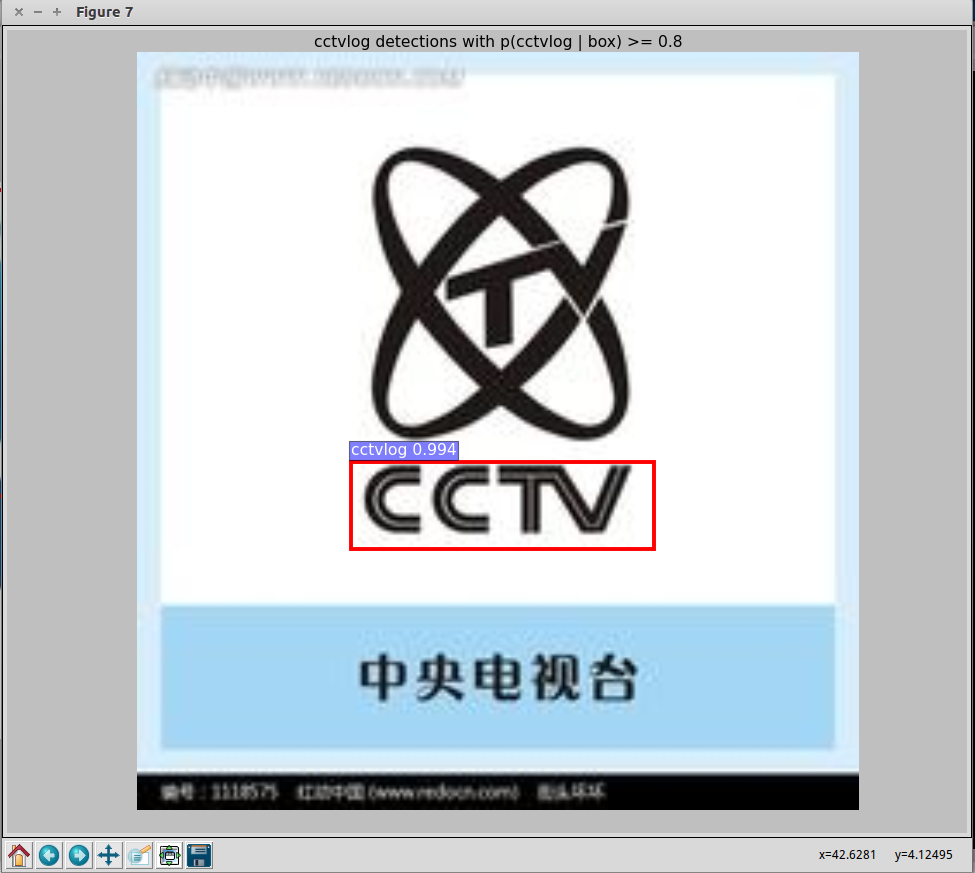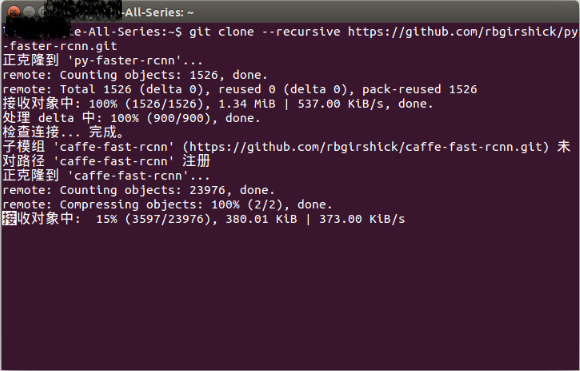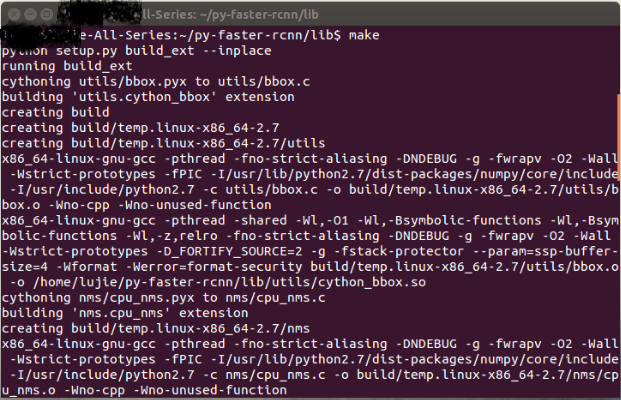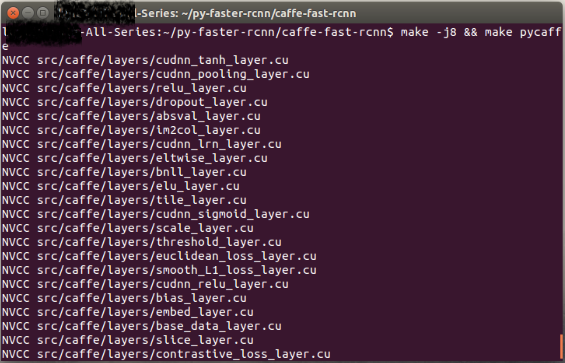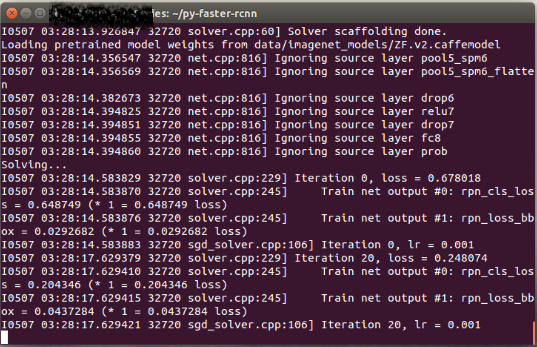Faster-RCNN+ZF用自己的資料集訓練模型(Python版本)
說明:本博文假設你已經做好了自己的資料集,該資料集格式和VOC2007相同。下面是訓練前的一些修改。
Faster-RCNN原始碼下載地址:
本文用到的是Python版本,在Linux下執行。
準備工作:
1.配置caffe
這個不多說,網上教程很多。
2.其他的注意事項
下面大概翻譯一下上面網址的內容吧。
(1)安裝cython, python-opencv,easydict
pip install cython
pip install easydict
apt-get install python-opencv(2)下載py-faster-rcnn
# Make sure to clone with --recursive git clone --recursive https://github.com/rbgirshick/py-faster-rcnn.git
如圖:
(3)進入py-faster-rcnn/lib
執行make
如圖:
(4)進入py-faster-rcnn\caffe-fast-rcnn
執行 cp Makefile.config.example Makefile.config
然後,配置Makefile.config檔案,可參考我的配置:Makefile.config檔案
配置好Makefile.config檔案後,執行:
make -j8 && make pycaffe如圖:
(5)下載VOC2007資料集
解壓,然後,將該資料集放在py-faster-rcnn\data下,用你的資料集替換VOC2007資料集。(替換Annotations,ImageSets和JPEGImages)
(用你的Annotations,ImagesSets和JPEGImages替換py-faster-rcnn\data\VOCdevkit2007\VOC2007中對應資料夾)
(6)下載ImageNet資料集下預訓練得到的模型引數(用來初始化)
解壓,然後將該檔案放在py-faster-rcnn\data下
下面是訓練前的一些修改。
1.py-faster-rcnn/models/pascal_voc/ZF/faster_rcnn_alt_opt/stage1_fast_rcnn_train.pt修改
layer { name: 'data' type: 'Python' top: 'data' top: 'rois' top: 'labels' top: 'bbox_targets' top: 'bbox_inside_weights' top: 'bbox_outside_weights' python_param { module: 'roi_data_layer.layer' layer: 'RoIDataLayer' param_str: "'num_classes': 16" #按訓練集類別改,該值為類別數+1 } }
layer {
name: "cls_score"
type: "InnerProduct"
bottom: "fc7"
top: "cls_score"
param { lr_mult: 1.0 }
param { lr_mult: 2.0 }
inner_product_param {
num_output: 16 #按訓練集類別改,該值為類別數+1
weight_filler {
type: "gaussian"
std: 0.01
}
bias_filler {
type: "constant"
value: 0
}
}
}layer {
name: "bbox_pred"
type: "InnerProduct"
bottom: "fc7"
top: "bbox_pred"
param { lr_mult: 1.0 }
param { lr_mult: 2.0 }
inner_product_param {
num_output: 64 #按訓練集類別改,該值為(類別數+1)*4
weight_filler {
type: "gaussian"
std: 0.001
}
bias_filler {
type: "constant"
value: 0
}
}
}2.py-faster-rcnn/models/pascal_voc/ZF/faster_rcnn_alt_opt/stage1_rpn_train.pt修改
layer {
name: 'input-data'
type: 'Python'
top: 'data'
top: 'im_info'
top: 'gt_boxes'
python_param {
module: 'roi_data_layer.layer'
layer: 'RoIDataLayer'
param_str: "'num_classes': 16" #按訓練集類別改,該值為類別數+1
}
}3.py-faster-rcnn/models/pascal_voc/ZF/faster_rcnn_alt_opt/stage2_fast_rcnn_train.pt修改
layer {
name: 'data'
type: 'Python'
top: 'data'
top: 'rois'
top: 'labels'
top: 'bbox_targets'
top: 'bbox_inside_weights'
top: 'bbox_outside_weights'
python_param {
module: 'roi_data_layer.layer'
layer: 'RoIDataLayer'
param_str: "'num_classes': 16" #按訓練集類別改,該值為類別數+1
}
}layer {
name: "cls_score"
type: "InnerProduct"
bottom: "fc7"
top: "cls_score"
param { lr_mult: 1.0 }
param { lr_mult: 2.0 }
inner_product_param {
num_output: 16 #按訓練集類別改,該值為類別數+1
weight_filler {
type: "gaussian"
std: 0.01
}
bias_filler {
type: "constant"
value: 0
}
}
}layer {
name: "bbox_pred"
type: "InnerProduct"
bottom: "fc7"
top: "bbox_pred"
param { lr_mult: 1.0 }
param { lr_mult: 2.0 }
inner_product_param {
num_output: 64 #按訓練集類別改,該值為(類別數+1)*4
weight_filler {
type: "gaussian"
std: 0.001
}
bias_filler {
type: "constant"
value: 0
}
}
}4.py-faster-rcnn/models/pascal_voc/ZF/faster_rcnn_alt_opt/stage2_rpn_train.pt修改
layer {
name: 'input-data'
type: 'Python'
top: 'data'
top: 'im_info'
top: 'gt_boxes'
python_param {
module: 'roi_data_layer.layer'
layer: 'RoIDataLayer'
param_str: "'num_classes': 16" #按訓練集類別改,該值為類別數+1
}
}5.py-faster-rcnn/models/pascal_voc/ZF/faster_rcnn_alt_opt/faster_rcnn_test.pt修改
layer {
name: "cls_score"
type: "InnerProduct"
bottom: "fc7"
top: "cls_score"
inner_product_param {
num_output: 16 #按訓練集類別改,該值為類別數+1
}
}layer {
name: "bbox_pred"
type: "InnerProduct"
bottom: "fc7"
top: "bbox_pred"
inner_product_param {
num_output: 64 #按訓練集類別改,該值為(類別數+1)*4
}
}6.py-faster-rcnn/lib/datasets/pascal_voc.py修改
(1)class pascal_voc(imdb):
def __init__(self, image_set, year, devkit_path=None):
imdb.__init__(self, 'voc_' + year + '_' + image_set)
self._year = year
self._image_set = image_set
self._devkit_path = self._get_default_path() if devkit_path is None \
else devkit_path
self._data_path = os.path.join(self._devkit_path, 'VOC' + self._year)
self._classes = ('__background__', # always index 0
'你的標籤1','你的標籤2',你的標籤3','你的標籤4'
)上面要改的地方是
修改訓練集資料夾:
self._data_path = os.path.join(self._devkit_path, 'VOC'+self._year)用你的資料集直接替換原來VOC2007內的Annotations,ImageSets和JPEGImages即可,以免出現各種錯誤。
修改標籤:
self._classes = ('__background__', # always index 0
'你的標籤1','你的標籤2','你的標籤3','你的標籤4'
)修改成你的資料集的標籤就行。
(2)
cls = self._class_to_ind[obj.find('name').text.lower().strip()](去掉lower應該也行)
建議訓練的標籤還是用小寫的字母,如果最終需要用大寫字母或中文顯示標籤,可參考:
7.py-faster-rcnn/lib/datasets/imdb.py修改
該檔案的append_flipped_images(self)函式修改為:def append_flipped_images(self):
num_images = self.num_images
widths = [PIL.Image.open(self.image_path_at(i)).size[0]
for i in xrange(num_images)]
for i in xrange(num_images):
boxes = self.roidb[i]['boxes'].copy()
oldx1 = boxes[:, 0].copy()
oldx2 = boxes[:, 2].copy()
boxes[:, 0] = widths[i] - oldx2 - 1
print boxes[:, 0]
boxes[:, 2] = widths[i] - oldx1 - 1
print boxes[:, 0]
assert (boxes[:, 2] >= boxes[:, 0]).all()
entry = {'boxes' : boxes,
'gt_overlaps' : self.roidb[i]['gt_overlaps'],
'gt_classes' : self.roidb[i]['gt_classes'],
'flipped' : True}
self.roidb.append(entry)
self._image_index = self._image_index * 2!!!為防止與之前的模型搞混,訓練前把output資料夾刪除(或改個其他名),還要把py-faster-rcnn/data/cache中的檔案和
py-faster-rcnn/data/VOCdevkit2007/annotations_cache中的檔案刪除(如果有的話)。
至於學習率等之類的設定,可在py-faster-rcnn/models/pascal_voc/ZF/faster_rcnn_alt_opt中的solve檔案設定,迭代次數可在py-faster-rcnn\tools的train_faster_rcnn_alt_opt.py中修改:
max_iters = [80000, 40000, 80000, 40000]如果改了這些數值,最好把py-faster-rcnn/models/pascal_voc/ZF/faster_rcnn_alt_opt裡對應的solver檔案(有4個)也修改,stepsize小於上面修改的數值。
8.開始訓練
進入py-faster-rcnn,執行:
./experiments/scripts/faster_rcnn_alt_opt.sh 0 ZF pascal_voc這樣,就開始訓練了。
9.測試
將訓練得到的py-faster-rcnn\output\faster_rcnn_alt_opt\***_trainval中ZF的caffemodel拷貝至py-faster-rcnn\data\faster_rcnn_models(如果沒有這個資料夾,就新建一個),然後,修改:
py-faster-rcnn\tools\demo.py,主要修改:
CLASSES = ('__background__',
'你的標籤1', '你的標籤2', '你的標籤3', '你的標籤4')改成你的資料集標籤;
NETS = {'vgg16': ('VGG16',
'VGG16_faster_rcnn_final.caffemodel'),
'zf': ('ZF',
'ZF_faster_rcnn_final.caffemodel')}上面ZF的caffemodel改成你的caffemodel。
im_names = ['1559.jpg','1564.jpg']改成你的測試圖片。(測試圖片放在py-faster-rcnn\data\demo中)
10.結果
在py-faster-rcnn下,
執行:
./tools/demo.py --net zf或者將預設的模型改為zf:
parser.add_argument('--net', dest='demo_net', help='Network to use [vgg16]',
choices=NETS.keys(), default='vgg16')default='zf'./tools/demo.py